医学影像学简答题(Medical imaging simplified answer )
- 格式:doc
- 大小:48.00 KB
- 文档页数:19
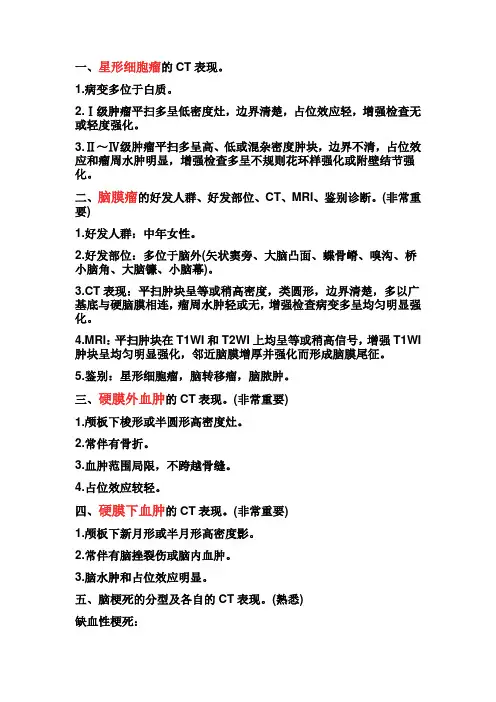
一、星形细胞瘤的CT表现。
1.病变多位于白质。
2.Ⅰ级肿瘤平扫多呈低密度灶,边界清楚,占位效应轻,增强检查无或轻度强化。
3.Ⅱ~Ⅳ级肿瘤平扫多呈高、低或混杂密度肿块,边界不清,占位效应和瘤周水肿明显,增强检查多呈不规则花环样强化或附壁结节强化。
二、脑膜瘤的好发人群、好发部位、CT、MRI、鉴别诊断。
(非常重要)1.好发人群:中年女性。
2.好发部位:多位于脑外(矢状窦旁、大脑凸面、蝶骨嵴、嗅沟、桥小脑角、大脑镰、小脑幕)。
3.CT表现:平扫肿块呈等或稍高密度,类圆形,边界清楚,多以广基底与硬脑膜相连,瘤周水肿轻或无,增强检查病变多呈均匀明显强化。
4.MRI:平扫肿块在T1WI和T2WI上均呈等或稍高信号,增强T1WI 肿块呈均匀明显强化,邻近脑膜增厚并强化而形成脑膜尾征。
5.鉴别:星形细胞瘤,脑转移瘤,脑脓肿。
三、硬膜外血肿的CT表现。
(非常重要)1.颅板下梭形或半圆形高密度灶。
2.常伴有骨折。
3.血肿范围局限,不跨越骨缝。
4.占位效应较轻。
四、硬膜下血肿的CT表现。
(非常重要)1.颅板下新月形或半月形高密度影。
2.常伴有脑挫裂伤或脑内血肿。
3.脑水肿和占位效应明显。
五、脑梗死的分型及各自的CT表现。
(熟悉)缺血性梗死:1.低密度梗死灶,部位和范围与闭塞血管供血区一致。
2.皮髓质同时受累。
3.占位效应较轻。
4.增强扫描可见脑回状强化。
出血性梗死:1.低密度的梗死灶内可见高密度的出血灶。
2.占位效应明显。
腔隙性梗死:1.低密度梗死灶。
2.无占位效应。
六、鼻咽癌的CT表现。
(非常重要)1.平扫表现为患侧咽隐窝变浅、消失或隆起。
2.咽顶、后、侧壁肿块突向鼻咽腔。
3.颈深淋巴结肿大。
4.增强检查病变呈不均匀明显强化。
七、癌性空洞、结核空洞和脓肿空洞的鉴别。
(一般重要)1、癌性空洞:多见于老年患者。
多位于肺上叶前段和下叶基底段。
多为厚壁偏心空洞。
内壁不光整,可有壁结节,外壁可有分叶征及毛刺征。
常伴肺门、纵隔淋巴结增大。
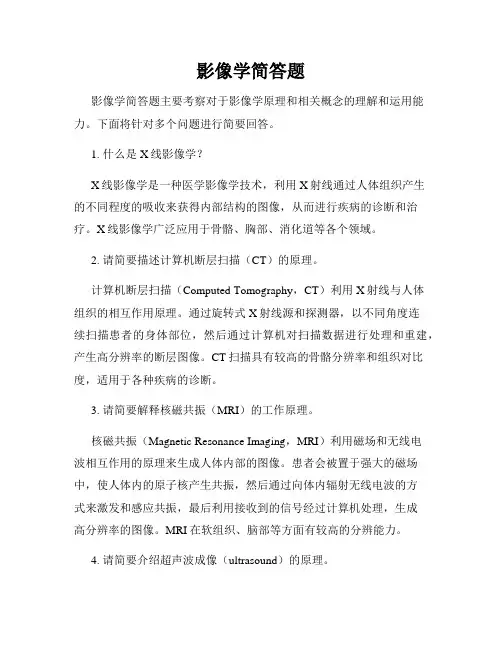
影像学简答题影像学简答题主要考察对于影像学原理和相关概念的理解和运用能力。
下面将针对多个问题进行简要回答。
1. 什么是X线影像学?X线影像学是一种医学影像学技术,利用X射线通过人体组织产生的不同程度的吸收来获得内部结构的图像,从而进行疾病的诊断和治疗。
X线影像学广泛应用于骨骼、胸部、消化道等各个领域。
2. 请简要描述计算机断层扫描(CT)的原理。
计算机断层扫描(Computed Tomography,CT)利用X射线与人体组织的相互作用原理。
通过旋转式X射线源和探测器,以不同角度连续扫描患者的身体部位,然后通过计算机对扫描数据进行处理和重建,产生高分辨率的断层图像。
CT扫描具有较高的骨骼分辨率和组织对比度,适用于各种疾病的诊断。
3. 请简要解释核磁共振(MRI)的工作原理。
核磁共振(Magnetic Resonance Imaging,MRI)利用磁场和无线电波相互作用的原理来生成人体内部的图像。
患者会被置于强大的磁场中,使人体内的原子核产生共振,然后通过向体内辐射无线电波的方式来激发和感应共振,最后利用接收到的信号经过计算机处理,生成高分辨率的图像。
MRI在软组织、脑部等方面有较高的分辨能力。
4. 请简要介绍超声波成像(ultrasound)的原理。
超声波成像利用高频声波在人体内部的传播和反射产生图像。
医生会将超声探头放置在患者皮肤上,并通过向体内发送超声波脉冲,然后接收由组织反射回来的声波信号,再经过处理和重建,生成图像。
超声波成像无辐射,对于产妇和婴儿等使用较为安全,常用于妇产科、心脏等领域的检查。
5. 请简要解释放射性核素扫描(Radionuclide scanning)的原理。
放射性核素扫描利用放射性同位素在体内的分布情况获得图像信息,从而观察某一器官的功能和代谢活动。
在这种扫描中,放射性核素会注射到患者体内,并发射出γ射线。
接着,探测器将记录这些射线的分布情况,并通过计算机进行处理和图像重建。
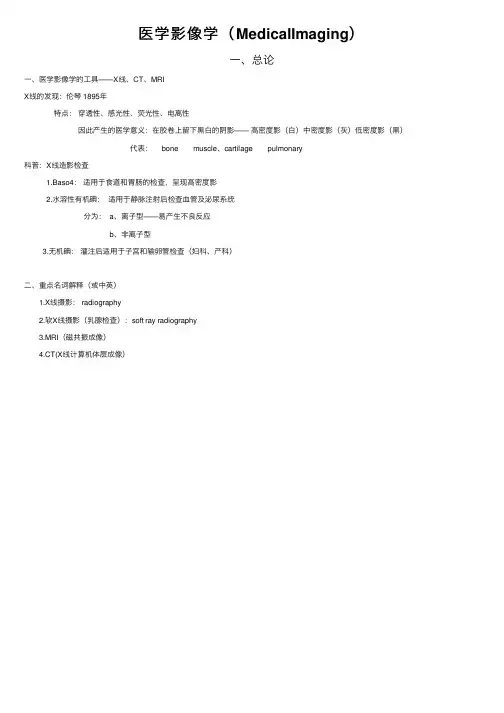
医学影像学(MedicalImaging)
⼀、总论
⼀、医学影像学的⼯具——X线、CT、MRI
X线的发现:伦琴 1895年
特点:穿透性、感光性、荧光性、电离性
因此产⽣的医学意义:在胶卷上留下⿊⽩的阴影—— ⾼密度影(⽩)中密度影(灰)低密度影(⿊) 代表: bone muscle、cartilage pulmonary
科普:X线造影检查
1.Baso4:适⽤于⾷道和胃肠的检查,呈现⾼密度影
2.⽔溶性有机碘:适⽤于静脉注射后检查⾎管及泌尿系统
分为: a、离⼦型——易产⽣不良反应
b、⾮离⼦型
3.⽆机碘:灌注后适⽤于⼦宫和输卵管检查(妇科、产科)
⼆、重点名词解释(或中英)
1.X线摄影: radiography
2.软X线摄影(乳腺检查):soft ray radiography
3.MRI(磁共振成像)
4.CT(X线计算机体层成像)。
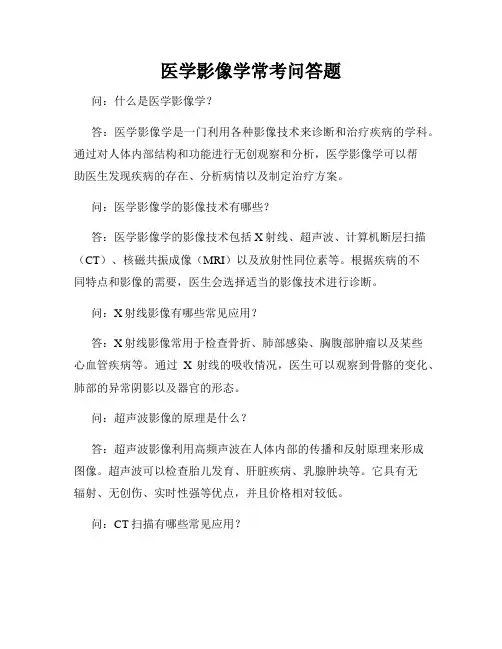
医学影像学常考问答题问:什么是医学影像学?答:医学影像学是一门利用各种影像技术来诊断和治疗疾病的学科。
通过对人体内部结构和功能进行无创观察和分析,医学影像学可以帮助医生发现疾病的存在、分析病情以及制定治疗方案。
问:医学影像学的影像技术有哪些?答:医学影像学的影像技术包括X射线、超声波、计算机断层扫描(CT)、核磁共振成像(MRI)以及放射性同位素等。
根据疾病的不同特点和影像的需要,医生会选择适当的影像技术进行诊断。
问:X射线影像有哪些常见应用?答:X射线影像常用于检查骨折、肺部感染、胸腹部肿瘤以及某些心血管疾病等。
通过X射线的吸收情况,医生可以观察到骨骼的变化、肺部的异常阴影以及器官的形态。
问:超声波影像的原理是什么?答:超声波影像利用高频声波在人体内部的传播和反射原理来形成图像。
超声波可以检查胎儿发育、肝脏疾病、乳腺肿块等。
它具有无辐射、无创伤、实时性强等优点,并且价格相对较低。
问:CT扫描有哪些常见应用?答:CT扫描通过旋转X射线源和探测器来获取横断面图像,可以检查头部、胸腹部、盆腔等部位的疾病。
其应用范围广泛,可以检查肿瘤、血栓、脑出血、骨折等情况。
问:MRI扫描适用于哪些疾病诊断?答:MRI扫描利用强磁场和无线电波来生成图像,可以观察软组织的结构和功能。
因此,MRI适用于脑部疾病(如脑肿瘤、脑卒中)、脊柱疾病、关节问题以及心脏、肝脏等器官的检查。
问:放射性同位素扫描的作用是什么?答:放射性同位素扫描是一种核医学检查方法,通过给患者注射少量放射性同位素并观察其分布情况,可以研究器官的代谢、功能以及异常情况。
放射性同位素扫描可用于检查骨骼、肌肉、甲状腺等疾病。
问:医学影像学有哪些风险和注意事项?答:尽管医学影像学是无创诊断的一种方法,但在一些特殊情况下,仍然可能存在一定的风险。
例如,对于孕妇来说,某些影像技术(如CT和放射性同位素扫描)可能对胎儿产生影响,因此在进行此类检查时要特别谨慎。
此外,患者在进行影像检查前应向医生提供详细的病史,包括是否对某些物质或药物过敏等,以避免不必要的风险。
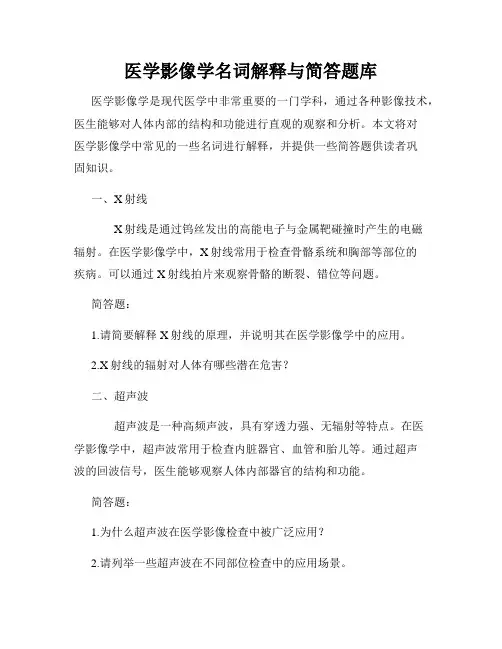
医学影像学名词解释与简答题库医学影像学是现代医学中非常重要的一门学科,通过各种影像技术,医生能够对人体内部的结构和功能进行直观的观察和分析。
本文将对医学影像学中常见的一些名词进行解释,并提供一些简答题供读者巩固知识。
一、X射线X射线是通过钨丝发出的高能电子与金属靶碰撞时产生的电磁辐射。
在医学影像学中,X射线常用于检查骨骼系统和胸部等部位的疾病。
可以通过X射线拍片来观察骨骼的断裂、错位等问题。
简答题:1.请简要解释X射线的原理,并说明其在医学影像学中的应用。
2.X射线的辐射对人体有哪些潜在危害?二、超声波超声波是一种高频声波,具有穿透力强、无辐射等特点。
在医学影像学中,超声波常用于检查内脏器官、血管和胎儿等。
通过超声波的回波信号,医生能够观察人体内部器官的结构和功能。
简答题:1.为什么超声波在医学影像检查中被广泛应用?2.请列举一些超声波在不同部位检查中的应用场景。
三、计算机断层扫描(CT)计算机断层扫描(CT)是一种通过X射线技术进行断层成像的方法。
通过将人体的扫描数据与计算机进行图像重建,医生可以获得高清晰度的体内结构图像,用于诊断疾病。
简答题:1.CT技术相比传统X射线拍片有哪些优势?2.请解释CT的扫描原理。
四、磁共振成像(MRI)磁共振成像(MRI)是一种利用核磁共振原理进行影像检查的技术。
它通过利用人体组织中的氢原子的运动状态来获得图像信息。
MRI在诊断肌肉骨骼、脑部疾病等方面具有很高的精确性。
简答题:1.简要解释MRI的原理,并说明其在医学影像学中的应用。
2.MRI相比CT有哪些优点和不足之处?五、放射性核素扫描放射性核素扫描是一种通过引入放射性标记物来观察人体内部组织和器官功能的方法。
医生会将放射性核素注射或摄入患者体内,然后通过特殊的设备对其进行扫描,以获得有关生物代谢和血流等方面的信息。
简答题:1.请简要说明放射性核素扫描的原理,并说明其适用场景。
2.放射性核素扫描对人体有哪些潜在危害?结束语:医学影像学是现代医学中非常重要的一门学科,它通过各种影像技术为医生提供了更直观、准确的信息,有助于快速准确地诊断疾病。
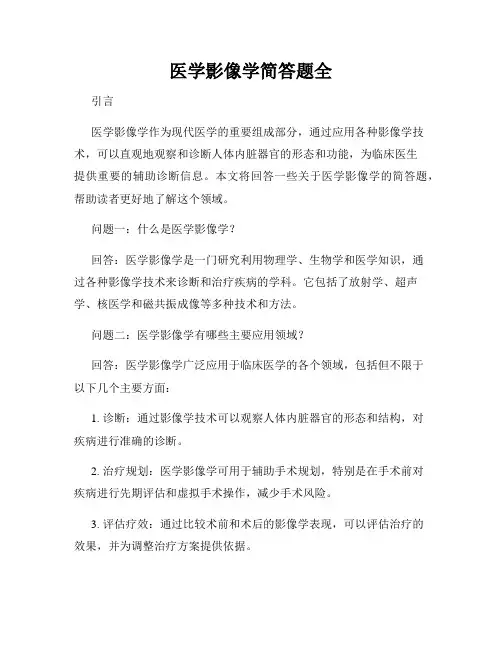
医学影像学简答题全引言医学影像学作为现代医学的重要组成部分,通过应用各种影像学技术,可以直观地观察和诊断人体内脏器官的形态和功能,为临床医生提供重要的辅助诊断信息。
本文将回答一些关于医学影像学的简答题,帮助读者更好地了解这个领域。
问题一:什么是医学影像学?回答:医学影像学是一门研究利用物理学、生物学和医学知识,通过各种影像学技术来诊断和治疗疾病的学科。
它包括了放射学、超声学、核医学和磁共振成像等多种技术和方法。
问题二:医学影像学有哪些主要应用领域?回答:医学影像学广泛应用于临床医学的各个领域,包括但不限于以下几个主要方面:1. 诊断:通过影像学技术可以观察人体内脏器官的形态和结构,对疾病进行准确的诊断。
2. 治疗规划:医学影像学可用于辅助手术规划,特别是在手术前对疾病进行先期评估和虚拟手术操作,减少手术风险。
3. 评估疗效:通过比较术前和术后的影像学表现,可以评估治疗的效果,并为调整治疗方案提供依据。
4. 临床研究:医学影像学技术可以用于疾病研究和新药试验,对疾病的发生机制和治疗方法进行探索。
问题三:医学影像学的常用技术有哪些?回答:医学影像学技术主要包括以下几种:1. 放射学:包括X射线摄影、计算机断层扫描(CT)、磁共振成像(MRI)和数字化减影血管造影(DSA)等技术,可用于观察人体内脏器官的形态和结构。
2. 超声学:通过利用超声波在人体组织中的传播和反射原理,产生图像来观察器官和组织的形状、结构和功能。
3. 核医学:利用放射性示踪物质追踪人体内的代谢过程,并通过测量射线释放的能量来形成影像,其中包括放射性核素摄取显像和正电子发射断层扫描(PET-CT)等技术。
4. 磁共振成像:通过利用磁场和电磁波的相互作用原理,观察和诊断人体内器官的结构和病变。
问题四:医学影像学的安全性如何?回答:医学影像学技术在临床应用中是相对安全的,但仍需注意以下几个方面:1. 辐射安全:放射学技术涉及的X射线和其他射线在高剂量下可能对人体产生损害。
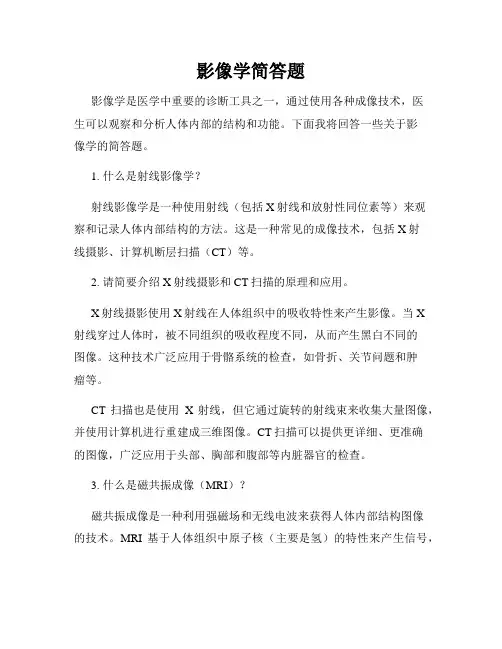
影像学简答题影像学是医学中重要的诊断工具之一,通过使用各种成像技术,医生可以观察和分析人体内部的结构和功能。
下面我将回答一些关于影像学的简答题。
1. 什么是射线影像学?射线影像学是一种使用射线(包括X射线和放射性同位素等)来观察和记录人体内部结构的方法。
这是一种常见的成像技术,包括X射线摄影、计算机断层扫描(CT)等。
2. 请简要介绍X射线摄影和CT扫描的原理和应用。
X射线摄影使用X射线在人体组织中的吸收特性来产生影像。
当X射线穿过人体时,被不同组织的吸收程度不同,从而产生黑白不同的图像。
这种技术广泛应用于骨骼系统的检查,如骨折、关节问题和肿瘤等。
CT扫描也是使用X射线,但它通过旋转的射线束来收集大量图像,并使用计算机进行重建成三维图像。
CT扫描可以提供更详细、更准确的图像,广泛应用于头部、胸部和腹部等内脏器官的检查。
3. 什么是磁共振成像(MRI)?磁共振成像是一种利用强磁场和无线电波来获得人体内部结构图像的技术。
MRI基于人体组织中原子核(主要是氢)的特性来产生信号,并通过计算机重建图像。
与X射线不同,MRI不涉及任何射线辐射,因此相对安全。
它被广泛应用于检查脑部、脊柱、关节和内脏器官。
4. CT扫描和MRI有何区别?CT扫描和MRI都可以提供详细的图像,但它们有一些区别。
首先,CT扫描使用的是X射线,这意味着对射线敏感的人可能会面临辐射风险。
而MRI则不使用射线,相对更安全。
其次,CT扫描的图像是基于组织对X射线的吸收情况,可以显示骨骼结构和实体肿块等,但对于软组织的对比度较低。
而MRI则以组织水含量、氢原子密度和自旋运动状态等为基础,对于软组织分辨率更高,对于神经系统的检查效果更佳。
5. 除了X射线和MRI,还有哪些常见的影像学技术?除了X射线和MRI,还有许多其他影像学技术。
例如超声波成像利用高频声波来产生图像,主要用于检查妇科、肝脏和心脏等器官。
核磁共振(NMR)是另一种使用原子核共振特性来获得图像的技术,用于检查例如肝脏和骨折的情况。

医学影像学简答题公司内部编号:(GOOD-TMMT-MMUT-UUPTY-UUYY-DTTI-简述肺充血与肺淤血的区别肺充血:肺动脉分支成比例地增粗且向外周伸展,边缘清晰锐利,肺野透明度正常,长期易导致肺动脉高压。
见于房间隔缺损,动脉导管未闭等左向右分流的先天性心脏病。
肺淤血:肺野透明度减低,肺门增大,边缘模糊,肺纹理增多增粗且边缘模糊。
简述房间隔缺损的X线表现肺血增多,肺动脉段突出,肺门动脉扩张,心影增大呈二尖瓣型,右房右室增大,主动脉结正常或缩小。
简述肝硬化的CT表现①全肝萎缩,肝各叶大小比例失常,尾叶与左叶较大,右叶较小②肝轮廓凹凸不平③肝门、肝裂增宽④出现脾肿大、腹水、胃底与食管静脉曲张等门静脉高压征象食管癌x线表现①粘膜破裂消失、中断、破坏代之以癌瘤杂乱不规则影像②管腔狭窄:为浸润型ca,管壁僵硬,上方扩张③腔内充盈缺损:见增生型ca,向腔内突出,不规则,大小不等充盈缺损;④不规则龛影:轮廓不规则长形龛影,溃疡型癌⑤受累段食管局限性僵硬,及形成纵隔内肿块影脑膜瘤CT表现CT 平扫:呈圆形等或略高密度,边界清晰,常见斑点状钙化广基底与硬膜相连,类圆形,周围水肿轻,静脉或静脉窦受压可出现中重度水肿侵犯相邻颅板引起增生或破坏。
增强:明显均匀强化。
简述大叶性肺炎的CT表现①充血期:病变呈磨玻璃样影,边缘模糊,病变区血管隐约可见②实变期:可见沿大叶或肺段分布的致密实变影,内有“空气支气管征”③消散期:实变影密度随病变吸收而减低,呈散在、大小不等的斑片状影。
简述绞窄性小肠梗阻的X线表现特点:①具有单纯性小肠梗阻征象:肠腔扩张积气、积液呈多发气液平征象;胃、结肠内气体减少或消失。
②假肿瘤征③咖啡豆征④肠袢卷曲固定征⑤长液平征⑥空回肠换位征⑦肠壁厚、液平面无波动、腹水等征象。
胸部影像学检查常采用哪些方法一、胸部透视二、拍片(正、侧位)三、高仟伏拍片四、体层摄影五、支气管造影六、CT七、MRI急性血性播散型肺结核的典型X线表现病变早期两肺密度增高呈毛玻璃样改变。
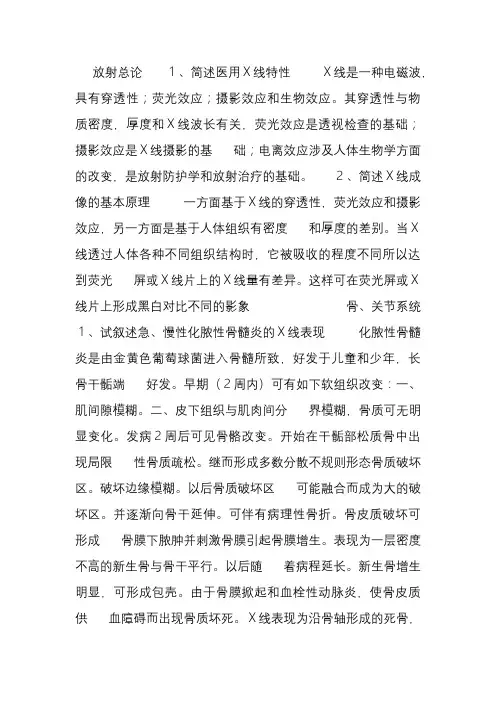
放射总论1、简述医用X线特性X线是一种电磁波,具有穿透性;荧光效应;摄影效应和生物效应。
其穿透性与物质密度,厚度和X线波长有关,荧光效应是透视检查的基础;摄影效应是X线摄影的基础;电离效应涉及人体生物学方面的改变,是放射防护学和放射治疗的基础。
2、简述X线成像的基本原理一方面基于X线的穿透性,荧光效应和摄影效应,另一方面是基于人体组织有密度和厚度的差别。
当X线透过人体各种不同组织结构时,它被吸收的程度不同所以达到荧光屏或X线片上的X线量有差异。
这样可在荧光屏或X线片上形成黑白对比不同的影象骨、关节系统1、试叙述急、慢性化脓性骨髓炎的X线表现化脓性骨髓炎是由金黄色葡萄球菌进入骨髓所致,好发于儿童和少年,长骨干骺端好发。
早期(2周内)可有如下软组织改变:一、肌间隙模糊。
二、皮下组织与肌肉间分界模糊,骨质可无明显变化。
发病2周后可见骨骼改变。
开始在干骺部松质骨中出现局限性骨质疏松。
继而形成多数分散不规则形态骨质破坏区。
破坏边缘模糊。
以后骨质破坏区可能融合而成为大的破坏区。
并逐渐向骨干延伸。
可伴有病理性骨折。
骨皮质破坏可形成骨膜下脓肿并刺激骨膜引起骨膜增生。
表现为一层密度不高的新生骨与骨干平行。
以后随着病程延长。
新生骨增生明显,可形成包壳。
由于骨膜掀起和血栓性动脉炎,使骨皮质供血障碍而出现骨质坏死。
X线表现为沿骨轴形成的死骨,密度甚高。
如病变部位靠近关节,脓肿可破坏干骺端骨皮质进入关节滑膜卡内。
引起化脓性关节炎。
X线表现为关节囊肿胀。
关节间隙早期增宽,甚至脱位。
晚期变窄。
骨性关节骨质破坏。
当急性化脓性骨髓炎未得到及时而充分的治疗。
可转化为慢性化脓性骨髓炎。
X线表现为大量骨质增生,骨膜增厚,并同皮质融合,呈分层状或花边状,骨皮质增厚,髓腔硬化变窄。
骨干增粗。
外形不规则,如未痊愈,则仍可见骨质破坏和死骨。
2、试叙述脊柱结核的X线表现是骨、关节结核的最常见者。
好发于儿童和青年。
以腰椎多发。
X线表现主要为骨质疏松和松质骨的骨质破坏。
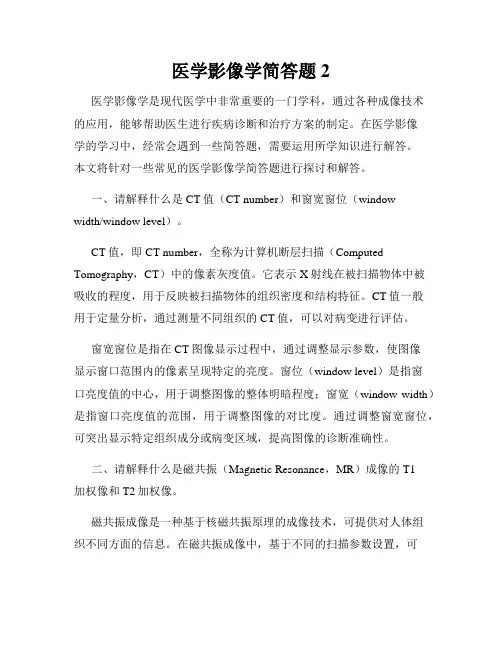
医学影像学简答题2医学影像学是现代医学中非常重要的一门学科,通过各种成像技术的应用,能够帮助医生进行疾病诊断和治疗方案的制定。
在医学影像学的学习中,经常会遇到一些简答题,需要运用所学知识进行解答。
本文将针对一些常见的医学影像学简答题进行探讨和解答。
一、请解释什么是CT值(CT number)和窗宽窗位(windowwidth/window level)。
CT值,即CT number,全称为计算机断层扫描(Computed Tomography,CT)中的像素灰度值。
它表示X射线在被扫描物体中被吸收的程度,用于反映被扫描物体的组织密度和结构特征。
CT值一般用于定量分析,通过测量不同组织的CT值,可以对病变进行评估。
窗宽窗位是指在CT图像显示过程中,通过调整显示参数,使图像显示窗口范围内的像素呈现特定的亮度。
窗位(window level)是指窗口亮度值的中心,用于调整图像的整体明暗程度;窗宽(window width)是指窗口亮度值的范围,用于调整图像的对比度。
通过调整窗宽窗位,可突出显示特定组织成分或病变区域,提高图像的诊断准确性。
二、请解释什么是磁共振(Magnetic Resonance,MR)成像的T1加权像和T2加权像。
磁共振成像是一种基于核磁共振原理的成像技术,可提供对人体组织不同方面的信息。
在磁共振成像中,基于不同的扫描参数设置,可得到不同类型的图像,其中T1加权像和T2加权像是磁共振成像中常见的两种类型。
T1加权像是指在扫描过程中,使短T1信号成分显示得较亮的图像。
T1加权像对脂肪和液体具有高信号强度,而对骨骼和纤维组织等组织成分则呈现低信号强度。
T1加权像适用于解剖学结构的显示和器官边界的清晰呈现。
T2加权像是指在扫描过程中,使长T2信号成分显示得较亮的图像。
T2加权像对水分和液体组分具有高信号强度,而对血管和脂肪等组织成分则呈现低信号强度。
T2加权像适用于检测炎症、水肿和肿瘤等病变。
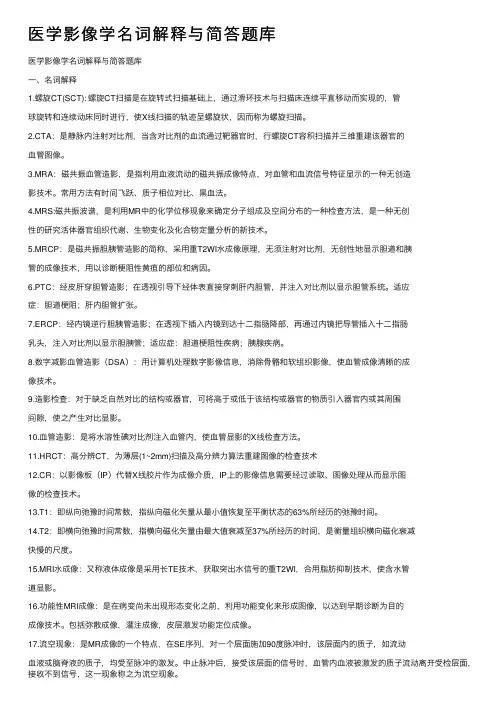
医学影像学名词解释与简答题库医学影像学名词解释与简答题库⼀、名词解释1.螺旋CT(SCT): 螺旋CT扫描是在旋转式扫描基础上,通过滑环技术与扫描床连续平直移动⽽实现的,管球旋转和连续动床同时进⾏,使X线扫描的轨迹呈螺旋状,因⽽称为螺旋扫描。
2.CTA:是静脉内注射对⽐剂,当含对⽐剂的⾎流通过靶器官时,⾏螺旋CT容积扫描并三维重建该器官的⾎管图像。
3.MRA:磁共振⾎管造影,是指利⽤⾎液流动的磁共振成像特点,对⾎管和⾎流信号特征显⽰的⼀种⽆创造影技术。
常⽤⽅法有时间飞跃、质⼦相位对⽐、⿊⾎法。
4.MRS:磁共振波谱,是利⽤MR中的化学位移现象来确定分⼦组成及空间分布的⼀种检查⽅法,是⼀种⽆创性的研究活体器官组织代谢、⽣物变化及化合物定量分析的新技术。
5.MRCP:是磁共振胆胰管造影的简称,采⽤重T2WI⽔成像原理,⽆须注射对⽐剂,⽆创性地显⽰胆道和胰管的成像技术,⽤以诊断梗阻性黄疽的部位和病因。
6.PTC:经⽪肝穿胆管造影;在透视引导下经体表直接穿刺肝内胆管,并注⼊对⽐剂以显⽰胆管系统。
适应症:胆道梗阻;肝内胆管扩张。
7.ERCP:经内镜逆⾏胆胰管造影;在透视下插⼊内镜到达⼗⼆指肠降部,再通过内镜把导管插⼊⼗⼆指肠乳头,注⼊对⽐剂以显⽰胆胰管;适应症:胆道梗阻性疾病;胰腺疾病。
8.数字减影⾎管造影(DSA):⽤计算机处理数字影像信息,消除⾻骼和软组织影像,使⾎管成像清晰的成像技术。
9.造影检查:对于缺乏⾃然对⽐的结构或器官,可将⾼于或低于该结构或器官的物质引⼊器官内或其周围间隙,使之产⽣对⽐显影。
10.⾎管造影:是将⽔溶性碘对⽐剂注⼊⾎管内,使⾎管显影的X线检查⽅法。
11.HRCT:⾼分辨CT,为薄层(1~2mm)扫描及⾼分辨⼒算法重建图像的检查技术12.CR:以影像板(IP)代替X线胶⽚作为成像介质,IP上的影像信息需要经过读取、图像处理从⽽显⽰图像的检查技术。
13.T1:即纵向弛豫时间常数,指纵向磁化⽮量从最⼩值恢复⾄平衡状态的63%所经历的弛豫时间。
医学影像学试题答案A一、填空题:1、关节基本病变包括(关节肿脓)(关节破坏)(关节退行变)(关节强直)(关节脱位)五选其三种。
2、MRI对(钙化)(细小骨化)的显示不如X线和CT。
3、异常心脏形态是(二尖瓣型心脏)(主动脉型心脏)(普大型心脏)4、正常成人心胸比是(0.5左右)横位心心脏纵轴与胸廓水平面夹角是(>45度)(45度)5、肾结石典型的X线表现(桑椹状)(鹿角状)(分层状)6、肺纹理由(肺动脉)、(肺静脉)组成,其中主要是(肺动脉分支),(支气管)、(淋巴管)及(少量间质组织)也参与肺纹理的形成。
7、肺叶间裂在普通CT上表现为(少量间质组织),在高分辨力CT图像上表现为(细线状或窄带状致密影)。
8、X线与医学成像有关的基本特性有(穿透作用)、(荧光作用)、(感光作用)、(电离作用/生物效应)。
9、肝癌CT增强扫描的特点是块进(快出)。
10、单纯性小肠梗阻的典型X线表现有(肠管扩张)、(阶梯状液气平面)。
二、名词解释:1、骨龄:骨的原始骨化中心和继发骨化中心的出现时间,骨骺与干骺端骨性愈合的时间有一定的规律性,用时间来表示即骨龄。
2、关节破坏:是关节软骨及其下方的骨性关节面骨质为病理组织所侵犯、代替所致。
3、骨质软化:是指一定单位体积内骨组织有机成分正常,而矿物质含量减少,组织学上显示骨样组织钙化不足。
4、冠心病定义:指冠状动脉硬化及功能性改变导致心肌缺血缺氧而引起的心脏病变5、肺充血:肺动脉内血容量增多6、法四:(1)肺动脉狭窄(2)室间隔缺损(3)主动脉骑跨(4)右室肥厚7、支气管气象:在X线胸片及CT片上,实变的肺组织中见到含气的支气管分支影(1分)。
可见于大叶性肺炎和小肺癌中(1分)。
8、充盈缺损:消化管腔内因隆起性病变而致使钡剂不能在该处充盈,该区域形成钡剂缺损表现。
常见于消化道占位性病变或异物。
9、半月综合征:溃疡型胃癌钡餐造影检查见到下列印象称为半月综合征:1、胃腔内充盈缺损肿块;2、肿块表面不规则半月形或盘状龛影,位于胃腔内;3、龛影周围围绕环堤,伴有指压迹状充盈缺损。
医学影像诊断学简答题集锦医学影像诊断学是一门关于利用各种医学影像技术对人体内部结构和功能进行观察、诊断以及疾病评估的学科。
下面我们来看一些关于医学影像诊断学的简答题集锦。
Q1: 什么是医学影像诊断学?医学影像诊断学是通过各种影像技术制取患者身体结构和功能的图像,以帮助医生进行疾病诊断的学科。
它包括X射线、CT扫描、MRI、超声波等不同的技术。
Q2: 医学影像诊断学有哪些常用技术?医学影像诊断学常用的技术包括X射线、CT扫描、MRI、超声波、核磁共振成像(MRS)、正电子发射断层扫描(PET)、深度学习等。
每种技术都有不同的优势和适用范围。
Q3: X射线影像诊断有哪些常见应用?X射线影像诊断常见应用于检查骨骼系统、胸部、消化系统以及泌尿系统等。
通过X射线片可以观察患者骨骼的结构、判断有无骨折等,对肺部疾病、心脏疾病、胃肠道问题等也有较好的影像显示。
Q4: CT扫描在医学影像诊断中的作用是什么?CT扫描是一种通过连续X射线图像来形成横断面图像的技术。
它在医学影像诊断中被广泛使用,可以用于骨骼结构、腹部、胸部等多个部位的检查。
由于其快速、准确、非侵入性等特点,CT扫描在肿瘤、结石、脑卒中等疾病的检测和评估中具有重要作用。
Q5: MRI在医学影像诊断中有哪些优势?MRI(磁共振成像)利用强磁场和无线电波通过对人体水分子的排列和运动状态进行测量,得到人体各部位的高质量图像。
相比于其他影像技术,MRI具有更高的分辨率,可以清晰显示软组织、脑部疾病以及心血管系统等问题。
Q6: 超声波在医学影像诊断中的应用范围有哪些?超声波是利用超声波的传播和反射原理来探测和描绘人体内部结构的技术。
它在妇科、产科、肝脏、甲状腺等多个领域有广泛应用。
超声波无辐射,对患者无损伤,适合于儿童、孕妇等特殊群体的检查。
Q7: 医学影像诊断中的深度学习技术有哪些应用?深度学习技术近年来在医学影像诊断领域取得了巨大的进展。
它可以自动提取图像特征,帮助医生快速和准确地进行疾病诊断。
1、原发性肝细胞癌答:CT表现:⑴平扫示肿瘤大多呈不均匀低密度影,癌灶内合并坏死和囊变或脂肪变性区则密度更低。
⑵肿块呈类圆形或不规则形,边界不清楚(浸润生长者),少数呈膨胀性生长者边缘有假包膜形成则边界清楚。
⑶肿瘤可造成局部膨隆,肝叶增大,肝内管道和肝门推移。
⑷肝硬化表现(肝叶比例失调、肝裂增宽、门脉高压等)。
⑸增强扫描:动态增强扫描:造影剂呈“快进快出”表现。
动脉期:肝癌为动脉供血,此期病灶明显强化,高于周围肝脏密度。
门静脉期:肿块密度开始下降,而正常肝组织逐渐明显强化,肿块呈等或略低密度平衡期:肿瘤呈明显低密度。
⑹肝癌侵犯门脉时可见血管内充盈缺损. ⑺转移征像:淋巴结肿大;远处转移等。
MRI表现:⑴T1WI上病灶多为边界不清楚稍低信号,T2WI上信号稍高于正常肝组织。
⑵如瘤灶内有脂肪变性、出血、坏死囊变等,可呈不均匀混合信号。
⑶Gd-DTPA动态增强表现同CT。
⑷假包膜:T1、T2均呈低信号,延迟后强化。
⑸用超顺磁性氧化铁(菲立磁)增强后,正常肝脏T2WI信号下降,而肝癌T2WI仍保持高信号。
2、胃溃疡答:直接征象:1)龛影:类园形钡斑,切线位位于胃轮廓外2)龛影口部水肿带:线征、项圈征、狭颈征3)粘膜纠集间接征象:(1)痉挛性改变(2)分泌增加(3)胃动力及张力异常(4)瘢痕收缩胃变形(5)幽门狭窄、梗阻早期胃癌:需用低张双对比造影。
胃小区粘膜结构紊乱、消失。
切线位上可见刺突样小龛影。
可见颗粒状、小圆形充盈缺损,表面毛糙不平。
中晚期胃癌:⑴胃腔内充盈缺损:缺损边缘轮廓不光整,形态不规则或呈分叶状。
⑵腔内龛影:龛影大而浅,形态不规则,多呈半月形,外缘平直,内缘不整,呈大小不一尖角样指向外周,常伴有“环堤”征及“半月综合征”。
⑶粘膜改变:粘膜皱襞局限性破坏、中断,周围粘膜粗大、僵直。
⑷胃轮廓改变:胃腔变形,边缘不整齐,胃壁僵硬,容积小且固定。
⑸病变部蠕动减弱或消失。
3.椎间盘突出答:X线:1)椎间隙异常:变窄、不等宽。
医学影像学简答题集锦1.X线成像的基本原理 5X线之所以能使人体组织结构形成影像,除了X线的穿透性、荧光效应和感光效应外,还基于人体组织结构之间有密度和厚度的差别。
当X线透过人体密度和厚度不同组织结构时,被吸收的程度不同,到达荧屏或胶片上的X线量出现差异,即产生了对比,在荧屏或X线片上就形成不同明暗或黑白灰度的对比的影像。
2.人体组织器官声学类型14反射类型二维超声图像表现组织器官无反射型液性暗区无回声尿、胆汁、囊肿液、血液等液性物质少反射型低亮度低回声心、肝、胰、脾等实质器官多反射型高亮度高回声血管壁、心瓣膜、脏器包膜、组织纤维化全反射型极高亮度强回声,后方有声影骨骼、钙斑、结石、含气肺、含气肠3.急性化脓性骨髓炎的X线表现 292①软组织肿胀:早期(发病2周内),肌间隙模糊或消失,皮下组织与肌间的分界模糊②骨质破坏:发病2周后,干骺端出现局限性骨质疏松,并形成骨质破坏区,边缘模糊,其内骨小梁模糊消失③骨皮质周围出现骨膜增生④死骨形成:骨皮质因血供障碍出现骨质坏死形成死骨,可引起病理性骨折【慢性化脓性骨髓炎:骨破坏周围有骨质增生硬化现象,皮质增厚,髓腔变窄闭塞,死骨和骨瘘管尚存】【急性化脓性关节炎:关节囊肿胀、关节间隙增宽;进展期关节软骨破坏引起关节间隙狭窄,继而发生关节软骨下骨质破坏,严重时可引起干骺端的骨髓炎;愈合期病变区骨质增生硬化,骨质疏松消失,严重时可形成骨性强直】4.干骺端结核的主要X线表现294①病变早期,患骨可见骨质疏松现象②骨松质中出现一局限性类圆形、边缘较清楚的骨质破坏区③在骨质破坏区有时可见“泥沙状”死骨④骨膜反应少见⑤病变发展易破坏骺而侵入关节,形成关节结核⑥干骺端结核很少向骨干发展,但病灶可破坏骨皮质和骨膜,此时可出现骨质增生和骨膜增生5.脊椎结核的X线表现 294①脊椎结核以腰椎多见,病变常累及相邻两个椎体,附件较少受累②主要引起骨松质破坏③椎体因承重而塌陷变扁呈楔形,椎间隙变窄甚至消失致相邻破坏的椎体互相融合,是脊椎结核的重要特征,受累脊柱节段常后突畸形④脊柱周围软组织中形成冷性脓肿【骨性关节结核:在干骺端关节结核的基础上,关节软组织总肿胀,关节间隙狭窄和骨质破坏。
医学影像学名词解释选择题简答题全套一、背景介绍医学影像学是现代医学中非常重要的一门学科,它通过应用各种成像技术,如X光、CT、MRI等,对人体内部进行观察和诊断。
在医学影像学的学习中,很多同学可能会遇到一些名词解释选择题和简答题,在这篇文章中,我将为大家提供一套全面的医学影像学名词解释选择题和简答题,以帮助大家更好地理解和掌握这门学科。
二、名词解释选择题1. 什么是放射线?A. 是电磁波的一种B. 是有电荷粒子的流动C. 是由高能粒子发出的光线D. 是电子从高能态返回低能态时发出的光线答案:A. 是电磁波的一种2. 什么是CT扫描?A. 通过探测人体的电磁感应现象,获取图像信息B. 通过射入X射线,经过人体后获取图像信息C. 通过磁场的改变,获取人体内部的图像信息D. 可以通过声波的反射来获取图像信息答案:B. 通过射入X射线,经过人体后获取图像信息3. 什么是MRI?A. 通过探测人体的电磁感应现象,获取图像信息B. 通过射入X射线,经过人体后获取图像信息C. 通过磁场的改变,获取人体内部的图像信息D. 可以通过声波的反射来获取图像信息答案:C. 通过磁场的改变,获取人体内部的图像信息4. 什么是超声波检查?A. 通过探测人体的电磁感应现象,获取图像信息B. 通过射入X射线,经过人体后获取图像信息C. 通过磁场的改变,获取人体内部的图像信息D. 可以通过声波的反射来获取图像信息答案:D. 可以通过声波的反射来获取图像信息三、简答题1. 请解释一下什么是X射线?X射线是一种高能电磁波,能够穿透人体组织,被不同密度的组织吸收的程度不同,通过探测X射线的吸收情况,可以得到人体内部的图像信息。
2. 请简要解释一下CT扫描的工作原理。
CT扫描通过射入X射线,经过人体后被不同组织吸收,探测器会接收到经过人体后剩余的X射线,并将其转化为电信号。
计算机会对这些电信号进行处理,生成一系列断层图像,再通过图像重建算法,将这些断层图像合成为一个整体的图像,以供医生进行诊断。
医学影像学简答题全在医学影像学领域,简答题是检验学生对于影像学知识的理解和应用能力的一种常见考试形式。
本文将回答几个常见的医学影像学简答题,帮助读者更好地了解相关知识。
1. 什么是医学影像学?医学影像学是一门通过使用放射学、超声学、磁共振等技术,对人体内部结构和功能进行非侵入性的可视化检查和诊断的医学学科。
它包括了各种影像技术的原理、应用和解读。
2. 什么是放射学?放射学是医学影像学的一个分支,利用放射线产生的影像来检查人体内部的结构和病变。
常见的放射学技术包括X射线、CT扫描和核医学等。
3. 什么是超声学?超声学利用高频声波在人体内部产生回音,通过接收和解读回音来得到人体内部结构和病变的影像。
它是一种安全、便捷和非侵入性的影像技术,常用于妇产科、心脏病学等领域。
4. 什么是磁共振成像(MRI)?磁共振成像是一种利用强磁场和无害的无线电波来产生人体内部图像的影像技术。
它可以提供高分辨率的解剖图像,并且对软组织的对比度较好,常被用于检查脑部、关节和脊柱等部位。
5. 什么是计算机断层扫描(CT)?计算机断层扫描是一种利用X射线和计算机技术来生成人体内部横断面图像的影像技术。
它可以提供高分辨率的解剖结构图像,并且对于检测肿瘤、受伤和感染等有很好的效果。
6. 什么是核医学?核医学是一种利用放射性药物并结合放射性探测器来检查人体器官和功能的影像技术。
它可以用于检查代谢活动、器官功能和疾病的变化,常用于心脏、肾脏和甲状腺等的诊断。
7. 影像学在临床上有什么应用?影像学在临床上有广泛的应用,可以用于疾病的早期诊断、病变的定位和评估治疗效果。
它常被用于检查肿瘤、骨折、器官损伤、内脏病变等,是现代医学诊断的重要工具。
8. 医学影像学的发展趋势是什么?随着科学技术的不断进步,医学影像学也逐渐向更加精准、智能化的方向发展。
例如,基于人工智能的影像解读系统可以帮助医生自动诊断,提高诊断的准确性和效率。
此外,更加个性化的影像检查和治疗方案也将成为未来发展的趋势。
医学影像学简答题1(Medical imaging simplified answer 1)3. Short answergeneral1. Brief description of medical X-ray characteristicsThe X ray is an electromagnetic wave with penetration; Fluorescence effect; Photographic effects and biological effects. Its penetration is related to material density, thickness and wavelength of X ray, and fluorescence effect is the basis of fluoroscopy. Photographic effect is the basis of X-ray photography; The ionization effect, which involves changes in human biology, is the basis of radiological protection and radiotherapy.2. The basic principle of X-ray imaging is describedOn the one hand, it is based on the penetration of the X ray, the fluorescence effect and the photographic effect, and on the other hand, the difference between the density and thickness of the body tissue. When the X rays penetrate various tissues of the human body, it is absorbed in different degrees so that there is a difference in the amount of X on the screen or in the X-ray. This allows for contrast between the black and white contrast on the screen or in the X-ray.Bones, joint systems1. The X-ray performance of acute and chronic suppurative osteomyelitisThe suppurative osteomyelitis is caused by staphylococcus aureus in the bone marrow, good hair in children and juvenile, long backbone epiphysis good hair. The early (2 weeks) may have the following soft tissue changes: 1. Two, subcutaneous tissue and muscle intersections blurred, bone may not have obvious change. Bone changes were seen after 2 weeks. The localized osteoporosis was started in the epiphyseal cancellous bone. Subsequently, most dispersed irregular form of bone destruction. Edge blur. In the future, the bone destruction area may merge into a large area of destruction. And gradually extend to the backbone. Can be accompanied by pathological fracture. Osteocortical destruction can form the subperiosteum abscess and stimulate the periosteum to cause periosteal hyperplasia. The new bone with low density is parallel to the backbone. Later, as the course of illness extended. The new osteogenesis is obvious and can form the shell. Osteonecrosis is caused by the emergence of periosteum and thrombotic arteritis. The X-ray shows the dead bone formed along the axis of the bone, which is very dense. If the lesion is close to the joint, the abscess can destroy the bone cortex of the dry epiphysis and enter the joint synovial card. Cause suppurative arthritis. The X line is the swelling of the joint capsule. The gap in the joint is widened early and even dislocated. Late narrowing. Osteopenia. When acute suppurative osteomyelitis is not treated promptly and adequately. It can be transformed into chronic suppurative osteomyelitis. The X-ray showed a large number of osteogenic hyperplasia, thickening of periosteum and fusion with cortex, which was stratified or lacy, thickening of the bony cortex, and narrowing of the medullary cavity. The backbone thickened. Irregular appearance, if not recovered,can still be seen bone destruction and dead bone.2. Describe the X - ray performance of the spine tuberculosisIt is the most common person of bone and joint tuberculosis. Good for children and young people. With lumbar multiple hair. The X - line performance is mainly osteoporosis and cancellous bone fracture. The attachment is less cumulative. Vertebral bodies often collapse due to bone damage, flattening or wedges. When the lesion is involved in the vertebral body, the lower margin of the bone. The rupture of the intervertebral cartilage plate is caused by the use of the broken cortex. When the intervertebral disc is invaded, the intervertebral space is narrowed. Even disappearing, the adjacent vertebral bodies are embedded and fused. At the same time, the lesion can produce a large number of caseous necrosis material in the destruction of bone, and the cold abscess is formed in the soft tissues around the spinal column.The X line is characterized by the presence of a fusiform soft shadow on both sides of the vertebral body, known as a lateral abscess. In addition, due to pathological fracture. The lateral spine of the spine can be seen to change the curvature of the spine. The post-emergence deformity.3. Test the X-ray performance of vitamin D deficiency ricketsBecause vitamin D is not a cause of calcium and phosphorus metabolism, osteoid tissue in bone is deficient in calcium salt deposits. Systemic metabolic bone disease. The X-ray showed a decrease in bone density in the general bone. Bone trabeculaeare rare, fuzzy, margin roughness, bony cortex thinned, stratified change. In the areas where bone metabolism is more active, such as the occurrence of bone epiphysis, the low density edge is blurred, and the epiphyseal calcification zone is irregular, blurred, thin and disappeared. In the middle of the epiphyses, there is a tortuous deformation in the middle of the epiphysis, with a very irregular margin and a hairbrush shape. The gap between the epiphysis and the epiphysis is widened. The corner of the epiphysis was altered by bone spur. The front of the thoracic ribs is a wide mouth. At the same time, the weight-bearing long bone is often bent and deformed. (O leg, X leg, etc.), a small number of patients can have a blue branch fracture healing X-ray performance: the temporary calcification belt reappears, the cup mouth shape depression and brush change are relieved and disappeared. The epiphyseal space is normal. Bone density increases and bone cortex thickens. Bone epiphysis increases, the density increases, and the bone deformation is prolonged.4. Test the differential diagnosis of benign and malignant bone tumors from the characteristics of X-ray.Benign:No transfer: no transfer.Growth condition: slow growth, non-invasion and adjacent tissues, but can be oppressive.Local bone changes: swelling bone damage, clear line with normal bone, sharp edge, thinning of the bony cortex, andexpansion can maintain continuity.Periosteum hyperplasia: generally no periosteal proliferation, can have a small amount of periosteum hyperplasia after pathological fracture, and periosteal new bone is not damage the surrounding soft tissue changes: no swelling or lump shadow more, if there are any lump, the edge is clear.Angiography: vascular differentiation is normal, and the tumor can be used to compress blood vessels.Malignant:Transfer: transfer.Growth: rapid growth, transsexual and adjacent tissue organs.Local bone changes: invasive bone fracture, blurred boundary and normal bone boundary, uneven edges, irregular fracture and defect, and bone formation of tumor.Periosteal hyperplasia: multiple forms of periosteal hyperplasia, and can be destroyed by tumor.The surrounding soft tissue changes: the growth of the soft tissue is not clear from the surrounding tissue.Angiography: it can be seen that tumor blood vessels are more and more disordered, the tumor staining and arteriovenous fistula, and the blood supply artery thickening and the blood vessel erosion become rigid, and the edge damage and so on.5. Take the femoral neck fracture as an example.1. Delayed healing or non-healing of fracture; X - ray showed delayed bone scab, with few or no presence, delayed or prolonged fracture line.Two, false joint formation: the X ray shows the bone bushy with the end of the bone, and there is a clear line between the two sides of the broken end.3. Fracture deformity healing: X - ray shows bone formation Angle, rotation, shortening deformity.4. After trauma, osteoporosis.5. Bone and joint infection; For acute chronic bone, arthritis X ray performance.6. Bone ischemic necrosis: increased femoral bone density and deformation.7. Joint rigidity: it is caused by adhesion to the joint, often with osteoporosis and soft tissue atrophy.Viii. Degeneration of joints: change after chronic bone injury.9. Ossified myositis: calcification in different degree of soft tissue after fracture.The respiratory system1. What methods are used in chest imaging examination?1. Chest perspective 2, (positive and lateral) 3, high - kilovol-meter 4, body layer photography 5, bronchography 6, CT 7, MRI2. What are the basic X-ray manifestations of lung lesions?A, exudative lesions: show the edge blur, density uniform shape shadow, range from flocculus to big leaf, when lesions involving the big leaf, its shape is in line with lung and sharp edges, air-bronchogram and visible.2. Fibrosis change: the expression is high density, the boundary is clear, walking rigid, irregular shape of the line shape.Iii. Proliferative lesion: localized nodules or petals, with high density, relatively clear edges, and generally no fusion trend.4. Calcified venereal changes: the appearance is sharp, the density is extremely high, the shape is different, the size of the speckle shape or plaque shape.Voids: 1. Wormwood vacuous cavity: manifested in a large number of pulmonary real changes with multiple small permeable areas. The form is irregular, it is wormlike. 2. Thin wall cavity: hollow wall thickness < 3mm, boundary clear, smooth circular light zone. 3. Thick wall hole: wall thickness > 3mm, the holeis round or irregular, peripheral or unreal change area, the inner wall is smooth and neat or concave, the hole can have or airless plane.Six, mass lesions, benign tumor characterized by round or oval, smooth boundary, density uniform spherical density shadow, malignant tumors are lobulated, the boundary is not sharp, can have a short nap or umbilical concave), central necrosis.3. With a solid shadow on one side of the chest, which diseases should be considered? What aspects should be analyzed in the identification?One, a large number of pleural effusion, one side of the lung, the one side of the lung, the one side of the pleural hypertrophy, the one side of the pleural hypertrophy, the one side of the lung, the one side of the lung and the one side of the lungShould note: when identifying a, mediastinal position 2, diaphragmatic level three, five, four, thoracic rib gap width size on a flat piece of six, observe whether air-bronchogram, observe whether the main bronchus is unobstructed in layer 7, combined with clinical data4. What are the direct and indirect X-ray signs of bronchial lung cancer (central type)?1. Lumps, located in the lung area, are rounded or lobule.2. Endobronchial polyps filling defect.3. The bronchial wall thickened and the lumen was narrow or blocked, with rat tail or cup.Ii. Indirect symptoms: 1. Obstructive pulmonary disease,The horizontal and pulmonary masses of the upper lobe of the upper lobe of the upper lobe of the upper lobe.2. Obstructive pneumonia: repeated attacks and slow absorption of exudative lesions.3. Obstructive emphysema: the air volume of the blocked lung is increased, and the brightness is increased.5. Typical X-ray manifestations of large leaf pneumonia?Lobule pneumonia may involve most or all of the lobes. The former is characterized by uniformity of density, and the shadow of the edge is indistinct. The edge is clear, with the interleaf crack as the boundary, its shape with the pulmonary lobe, the contour is consistent, its inside visible bronchi meteorology. Different forms of lobule pneumonia vary.6. Typical X-ray manifestations of acute hemorrhagic disseminated tuberculosis?The early two lung density of the lesion showed a change of hair glass. In about 10 days, the two lungs showed diffuse uniform distribution, the same size, uniform density of miliary nodules. The two lung textures are not clear.The circulatory system1. Simple mitral stenosis X-ray performance?The heart increases, the left atrium and right ventricle are enlarged, and the left heart is often significantly enlarged.The main reason for the reduction of the general aortic ball is the reduction of left ventricle blood elimination, aortic dysplasia or the left rotation of the heart and big blood vessels, and the aortic arch folds.The left ventricle shrank, the apex of the heart moved, the lower part of the heart was straight.4. Mitral membrane calcification, direct sign.5. Pulmonary congestion or interstitial edema, upper pulmonary vein dilation, lower pulmonary veins. Sometimes it can be seen that the diameter of 1 ~ 2mm in diameter can be seen in the lung field, which is composed of hemosiderosis.2. The X line of high blood heart disease is shown as?One, the heart is aortic type, the left ventricle segment increases, becomes round, the heart apex is in the phrenic, the cardiac phrenic horn shows acute Angle, the left ventricle is prominent, overlaps with the spine.Second, the left ventricle is increasing to the left, and the apex of the heart is often under the diaphragm.3. The perspective can be seen that the opposite pulsation.When left heart failure, the left atrium increases, and pulmonary congestion and pulmonary edema appear.5. Severe, the heart is generally enlarged, but the left ventricular enlargement is the main.The aorta has dilation, extension, and circuity.3. X-ray performance of pulmonary heart disease?Changes in pulmonary hypertension and chronic pulmonary diseaseOne, pulmonary hypertension, often occurs before the heart shape changes.Second, the right ventricle enlarges, the heart is in the mitral valve type, the heart rate is more than the normal person not much. Some cases: the heart is smaller than normal, and is related to the low level of the pulmonary emphysema.Three, chronic pulmonary disease, chronic bronchitis, extensive lung tissue fibrosis and emphysema.4. X ray performance of congenital heart disease atrial septal defect?When the defect is small, the size and shape of the heart andshape are normal or change.The heart is of mitral valve type, often moderate increase.Two, right atrium and right ventricular enlargement,The major characteristic changes of atrial septal defect were significantly increased in the right atrium.3. The pulmonary artery protruding, the pulsating enhancement, the pulmonary portal angiectasia. There are often lungmen dancing.In the left atrium, the left ventricle and aorta decreased, while the first left ventricle enlarged.5. Pulmonary hyperemia and later pulmonary hypertension.5. The X ray performance of common Fallot tetralogy?1. The heart is generally not enlarged, the heart is blunt, the upper warped is a sheep's nose, the heart lumbar depression, if there is a third ventricle forming, the heart is flat, or slightly raised.Second, the right ventricle increases.The left ventricle narrowed with decreased blood flow, the left atrium was generally unchanged, and the right atrium was mild to moderate due to increased blood flow and increased right ventricular pressure.4. The lung door shrinks and the lung vessels are slim.The aorta is widened and shifted to the right.The digestive system1. According to what characteristics can the organ of the digestive system be divided into two categories? Where are the organs?According to the characteristic of the digestive organ is the real organ or the hollow viscera, the digestive organ is divided into two categories. The liver and pancreas belong to the substantial organ. Esophagus, stomach, duodenum, large, small intestine and biliary system belong to hollow viscera.2. What kind of inspection methods and imaging methods are used in the two main types of digestive tract and cavity?The liver and pancreas of parenchyma were mainly used for CT, ultrasound and mri. After the general sweep; When necessary, CT iodine contrast agent was enhanced, and magnetic resonance was enhanced with gadolinium contrast agent.The hollow viscera was mainly used for routine X-ray examination, the gastrointestinal tract was radiographed by barium, and the bile was used for the contrast of iodine3. The X-ray signs of benign and malignant ulcers are identified.A benign ulcer protrudes from the gastric cavity. The ulcer is located within the contour of the stomach2. The shape of the shadow: the benign ulcer is relatively small and round, and the malignancy is larger and more shallow.Three, niche mouth: benign ulcer with mucosal edema, width is consistent, sometimes under pressure to change form malignant ulcer niches mouth cancer tissue invasion, forming ring levee involuntary pressure, change or more cancer nodules form refers to the indentation, sharp corners.Iv. Benign ulcer stomach constriction peristaltic direct niches, malignant ulcer is more than 1 cm from the niches, peristalsis disappears.4. Differentiation of esophageal foreign body and trachea foreign bodyTake the coin foreign object as an example, because the diameter of the esophagus is small, the left and right diameters are wider, so the esophageal foreign body is in a circular position, and the lateral position view is striped. The trachea foreign body is opposite, because the trachea half annular cartilage is absent is facing the rear, so the maximum diameter of the foreign body is the front and rear direction. The positive view is long and long, while the lateral position is round.5. Identification of jejunum, ileum and intestinal obstruction? How to diagnose low - level intestinal obstruction based on flatslice?The intestinal mucosa is a fish-bone arrangement perpendicular to the vertical axis of the intestinal tube. The mucosa of ileus is only two intestinal wall lines. The most significant expansion of the obstruction tube diameter is the semilinar fold.The high intestinal obstruction is mainly manifested in the left middle and upper abdominal multiple qi level, the stomach also sees the liquid level, the lower abdomen and the pelvic cavity of the lower abdomen and the lower gas. Low intestinal obstruction, the expression is the whole abdomen several stair - shaped gas levelUrinary system1. Differential diagnosis of urinary calculus. (points)1. Gallstones: the form is polygon, the surrounding density is high, the central density is low, sometimes there is the high density core. Lateral photography is located in front of the spine.Lymph node calcification: form irregular punctate, structure, and has no fixed position, to move a large degree (e.g., mesenteric lymph node calcification) imaging of the renal pelvis can understand outside or in the urinary tract.3. Intestinal contents (coprolites or drugs) : the position is not constant, the repeated photo position can be changed ordisappeared, and the bowel will disappear.Iv. Venous stone (pelvic cavity) : small, round, circular or concentric round dense shadow, the edges are neat, often for both sides and multiple, the position is more than partial, when necessary retrograde contrast imaging is identified.2. X-ray manifestations of renal tuberculosis. (points)Flat slice: the kidney contour area can protrude, terminal form shrinksCalcification: diffuse, cloudy, spottedAngiography: wormhole destruction, renal cortical abscess and vacuous formation, pyelonephrosis, renal pelvis, renal calyx (peripheral imformation, deformed stenosis), renalself-truncation3. The X-ray of typical urinary calculi. (points)Kidney: sliced: mulberry, layered, antlerContrast: density, higher density, filling defect, obstructionUreter: flat slice: the long axis is consistent with the ureterAbdominal segment: side of the lumbar spineThe sacroiliac segment: the sacroiliac jointPelvic segment: roughly parallel to the pelvic rimLower end of ureter: polymorphismContrast: positive, negative and catheter relationship, obstruction of waterBladder calculi: above the symphysis pubis, the midline of the pelvic cavity changes with positionUrethra: the posterior urethra: the symphysis of the pubic bone and the posterior urethra4. Several common radiographic reflux X - ray manifestations.1. Tubule reflux: the radiate dense shadow radiated from the center of the kidney to the cortex.Second, the kidney sinus reflux: it appears as the irregular Angle or band dense shadow around the fornix, and the author appears in an irregular shape.Iii. Circumfluence of the blood vessels: the arch of the arch is shown as the arch of the arch.Iv. Lymphatic reflux: it is shown as a slender, meandering, curved silhouette that walks in the direction of the renal gate.5. Various imaging examinations and USES of urinary system. (points)IVP: the shape of the renal pelvis, renal calices, ureters, and bladder, and the function of the renal excretion2. Retrograde pyelography: used for IVP display (such as renal dysfunction) or not for IVP (such as liver and kidney function, iodine allergy)Bladder angiography: excretory method: the urethral stricture cannot be intubated or at the same time, the upper urinary tract should be examinedRetrograde: observe bladder size, shape, position to diagnose bladder disease4. Urethrography: mostly used for urethral stricture, calculi, congenital malformation, etc5. Retroperitoneal aerated angiography: showing the renal, adrenal profile and retroperitoneal mass and the relationship with the kidney6. Arteriography: diagnosis of vascular lesions and adrenal neoplastic lesionsCentral, five official system1. Evaluation of CT in the treatment of sinus tumors.CT diagnosis of smaller tumors is of great value and can be determined in its origin and scope. Benign tumor margins are clear and orderly, without bone damage. But it is difficult todetermine the pathological nature. The mucous cyst showed an enlarged sinus cavity and increased density. CT is of great value in diagnosis of malignant tumor. In the early stage of osteopenia, there was a shadow of mass in the sinus cavity, and the sinus cavity was seen in the sinus cavity. The sinus wall can be damaged early, and the adjacent structure can be shown as the nasal cavity, the invasion of the orbit and the scope.2. CT manifestations of meningiomas.The CT findings of typical meningiomas are high in density, with clear edges, spherical or subleaf lesions, and cranial bones, which are connected to the cerebellum. There was no edema or slight edema in the oven. The general performance of the enhanced scanning was significantly enhanced.。